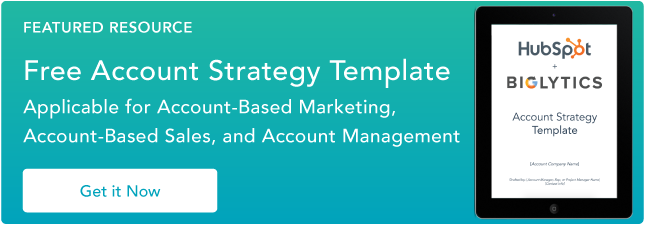In this space, Strategic Account Managers identify and create opportunities by positioning solutions aligned with customer goals, challenges, and initiatives. By focusing on strategic account management, sales professionals can grow accounts and enjoy other benefits, including:
Once the deal has been closed, the company needs to be able to dedicate efforts on maintaining and growing these relationships. In doing so, existing accounts can grow, offering many benefits, including:
- Shorter sales cycles
- Reduced acquisition costs
- Priority relationships
- Greater access to decision-makers
It is important to note, that in an ideal state strengthening relationships with valuable accounts should come from dedicated support in the form of Strategic Account Managers so sales reps can focus on closing new deals.
In this post, we’ll ways your company can leverage strategic account management in your pursuit of opportunities with existing customers.
Strategic Account Manager Job Description
Ready to add a Strategic Account Manager to your team? Here’s a job description to help you find a qualified candidate.
[Your Company Name] is hiring a Strategic Account Manager.
This role is responsible for managing relationships with our most valued customers. As a Strategic Account Manager, you will oversee customer retention, satisfaction, and revenue growth strategy.
In this position, you will:
- Serve as the main point of contact for your assigned accounts.
- Get to know your assigned accounts to understand their opportunities and challenges.
- Identify how our company can support the customer’s opportunities and challenges.
- Monitor the satisfaction level of your customer accounts and report progress to internal stakeholders.
- Be on point as the internal company contact regarding your customer accounts.
Skills and qualifications:
- Must have hands-on experience and demonstrated success managing multiple key customer accounts.
- Strong relationship-building skills to build trust and rapport with customer account stakeholders.
- Effective written and verbal communication skills.
- Excellent customer service skills.
- Data reporting and analytical skills; must be able to pull and analyze key metrics to measure the results of customer retention and satisfaction.
- Creative problem-solver.
- Sales experience — meeting quota should be the norm.
Strategic Account Management Process
To ensure success implementing the strategic account management process, consider these best practices.
1. Focus on the right customers.
Growing a current relationship starts with smart customer selection. Salespeople must take the time to determine which of their accounts represent the most significant opportunities. How? By finding the overlap between the customer’s strategic initiatives and your solutions.
In this early stage, examine "hard" factors — including revenue generated and product mix — and "soft" factors, such as level of access, relationships, and buying behavior.
Consider the divisions, departments, and locations within a target account. The best opportunities aren’t necessarily found in the accounts that have spent the most. In fact, these accounts often represent fewer sales opportunities because they’ve spent so much. Look for the accounts with the most significant potential for future purchases.
2. Analyze customer needs.
Targeting an existing account requires as much foresight as targeting a new one. Though salespeople already have access to some stakeholders, it’s still crucial to build a plan. This process begins by understanding the buyer’s journey, which helps sales professionals align their activities to the customer’s place in the buying process.
Of course, the buyer’s journey begins when they encounter a challenge in their pursuit of long-term goals and short-term objectives. The value of expanding existing accounts is it places the sales professional on this path early. You’re there to greet your customer when they arrive, so to speak.
In these initial stages, sales professionals can shape the customer’s thinking and properly frame their needs. This level of influence comes from salespeople who become trusted advisors. Reaching this point means you’ve provided insight to the customer and have taken the time to understand their business.
A trusted advisor can even be the person who triggers the buyer’s journey. This position is powerful and influential because, as McKinsey says, "research has found that journey performance is significantly more strongly linked to economic outcomes than are touchpoints alone."
3. Align with the customer.
A compelling solution is not enough. Salespeople need to be better than the competition. They must find alignment with the customer, so the value of the solution resonates with their business need. This step is critical, because it differentiates their solution from competitors.
Creating alignment involves stakeholder analysis. Sales professionals need to understand who will make the buying decision. Some of these stakeholders will have an existing relationship with the sales professional. Others will be new.
Taking a strategic approach means engaging established relationships to expand to new ones. The process is ongoing because stakeholders enter and exit the picture.
4. Engage customer needs
Business drivers change — and that’s a good thing. These changes are exactly why the business needs solutions in the first place. To track these changes in real-time, however, salespeople must keep the customer engaged. Without a high level of communication, they risk presenting solutions and insights that don’t resonate with their customer.
Regular dialogue clarifies evolving needs and boosts profitability, because fully engaged customers are more profitable than average customers. According to findings from Gallup, 40% of customers who are highly satisfied with their account manager are deeply engaged.
5. Measure success.
Strategic account managers must be able to demonstrate success to both their customers and stakeholders within their company. Customers who engage in a long-term partnership with an account manager expect a personalized experience that will help them achieve their goals and keep their business running smoothly.
Using a CRM to track customer communications can help Strategic Account Managers stay on top of their valuable partnerships.
When you are able to measure and document successful conversations and support initiatives for your customer, you gain valuable insight on how to continue having a fruitful partnership.
Additionally, those who manage strategic accounts must be able to measure and report success to their company’s stakeholders. If a company is allocating resources to strategic account management, there is an expectation that the account will be able to generate significant revenue to justify the investment. Strategic account managers must be able to demonstrate success for their company.
Strategic Account Management Planning Tools
With so many inputs to consider in the strategic account planning process, it’s important sales professionals have the right tools to manage and track their research and relationships.
There are many options for account planning tools and templates. Selecting the right tool is important, because your team needs a tool that’s robust enough to capture all critical customer information and lean enough to be put to practical use.
As you evaluate strategic account management tools and templates look for these key components:
- Industry Analysis Tool —Include a component that supports examination and documentation of external industry issues that may impact the customer.
- Customer Relationship Analysis Tool —Include a component that documents history with the customer and avenues for expansion -- like untapped business units and new divisions.
- Customer Strategy Map —Include a component that captures the customer’s strategy to determine which of their objectives and initiatives connect with the solution’s capabilities. List the customer’s goals, challenges, and culture.
- Stakeholder Assessment Tool —Include a component that helps your sales professionals categorize identified stakeholders by their role, level of influence, and alignment with the solution.
- Competitive Assessment Tool — Include a component where your team can review your competitive position from the customer’s perspective to identify ways to articulate your unique value.
To begin the strategic account planning process, check out HubSpot’s sales tools to facilitate mutually beneficial customer relationships and grow your business.
Ready to learn more about how account management can benefit your business? Check out this post to learn the difference between account management and sales.
Revenue Operations
.png?width=112&height=112&name=Image%20Hackathon%20%E2%80%93%20Vertical%20(34).png)



![A Successful Approach to Sales Account Planning [Template]](https://53.fs1.hubspotusercontent-na1.net/hubfs/53/Sales-Account-Planning-1-20240924-819784.webp)
.jpg)
.jpg)
![Account Management vs. Sales: What's the Difference? [FAQ]](https://53.fs1.hubspotusercontent-na1.net/hubfs/53/136_Account%20Management%20vs.jpg)